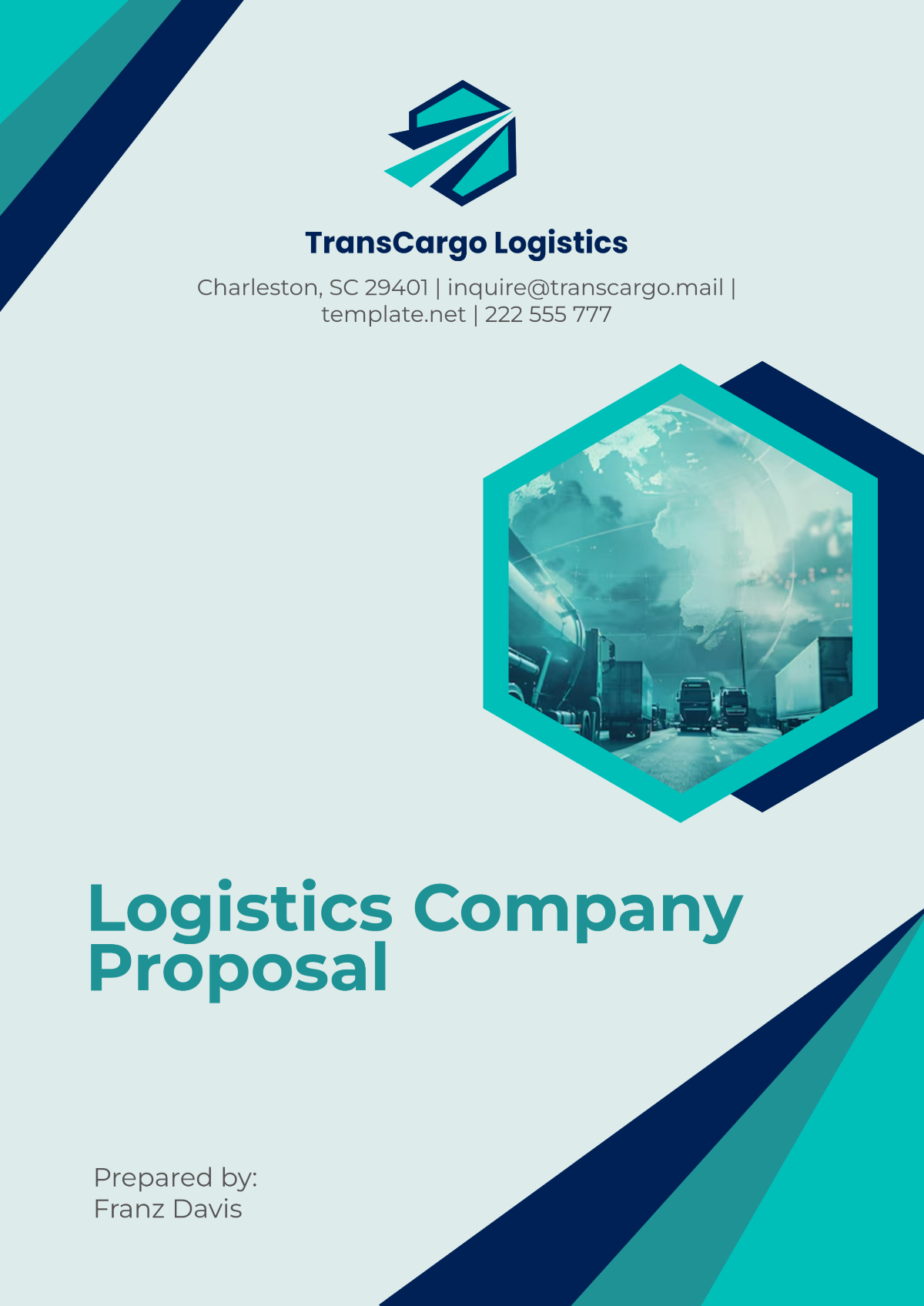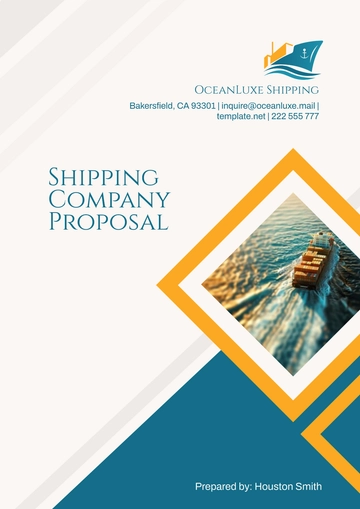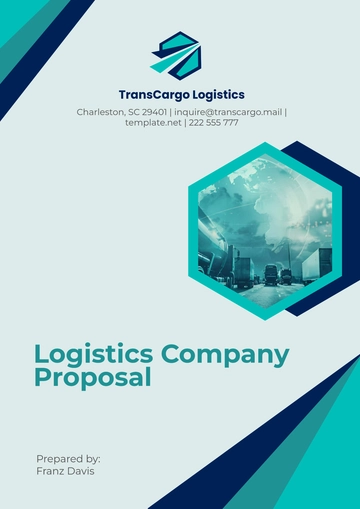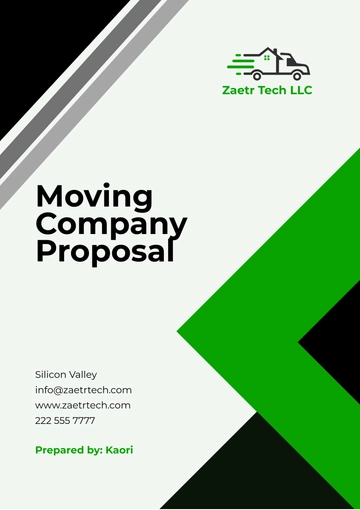Free Logistics Company Proposal

1. Executive Summary
1.1 Proposal Purpose
The purpose of this proposal is to outline a comprehensive logistics solution tailored to the needs of [Client Name]. Our goal is to streamline logistics processes, optimize delivery times, and reduce costs using advanced technology and efficient supply chain management. By implementing this logistics solution, [Client Name] will benefit from enhanced visibility, control, and flexibility in all logistics-related operations.
1.2 Summary of Services
[Your Company Name] will provide end-to-end logistics services, including transportation, warehousing, inventory management, and advanced digital tracking solutions. Our solution leverages cutting-edge technology, AI-driven route optimization, and predictive analytics to minimize downtime and maximize efficiency. Key services include:
Transportation Services: Reliable, multi-modal transport options.
Warehousing Solutions: Secure, scalable warehousing with temperature control.
Technology Integration: Real-time tracking and analytics through IoT.
Inventory Management: Automated restocking and demand forecasting.
1.3 Objectives and Goals
Our objectives are focused on delivering measurable improvements in logistics efficiency and cost savings for [Client Name]. Primary goals include:
Reduce Transport Costs: Achieve a [10%–15%] reduction in transport costs.
Increase Delivery Speed: Optimize routes to reduce delivery times by [25%].
Enhance Inventory Control: Lower stockouts and excess stock by maintaining optimal inventory levels.
Improve Visibility: Provide real-time tracking and comprehensive analytics to enable data-driven decision-making.
2. Company Overview
2.1 Background of [Your Company Name]
Established in [2050], [Your Company Name] is a leading logistics provider specializing in integrated, technology-driven supply chain solutions. With over [20] years of industry experience, we serve a diverse range of clients across sectors, including manufacturing, retail, and healthcare. We are committed to delivering superior service quality and continuously invest in state-of-the-art logistics technology.
2.2 Industry Experience
Our extensive industry experience enables us to handle complex logistics challenges and deliver customized solutions to meet each client’s unique needs. Our team comprises highly trained logistics experts, data scientists, and project managers dedicated to providing excellence at every step.
2.3 Key Capabilities
[Your Company Name] combines technological expertise with logistical know-how to provide services that are both innovative and reliable. Key capabilities include:
Digital Integration: Seamless integration with client systems for automated updates.
Sustainable Solutions: Environmentally friendly practices, with options for electric and hybrid vehicles.
24/7 Customer Support: Around-the-clock support for all logistics inquiries.
3. Scope of Services
3.1 Transportation Services
3.1.1 Freight Transportation
We offer a comprehensive range of freight transportation options, including air, land, and sea freight. Each mode is optimized for efficiency and cost-effectiveness to match [Client Name]'s specific requirements. We use predictive analysis to manage fleet maintenance and avoid disruptions.
Air Freight: Ideal for time-sensitive shipments, available for both domestic and international routes.
Land Freight: Includes truckload and less-than-truckload (LTL) services, with access to over [5,000] vehicles.
Sea Freight: Cost-effective for bulk goods, with weekly shipments to all major ports.
3.1.2 Last-Mile Delivery
Our last-mile delivery service ensures that shipments reach the final destination promptly and securely. With a network of delivery partners and an integrated tracking system, customers can view real-time updates on shipment status.
3.1.3 AI-Driven Route Optimization
Utilizing AI, our route optimization tool reduces fuel consumption by up to [20%] and delivery times by [15%], allowing for a smoother, faster logistics flow.
3.2 Warehousing Solutions
3.2.1 Inventory Warehousing
[Your Company Name] provides secure warehousing options with [1,000,000 sq. ft.] of storage space across multiple locations. Each warehouse is equipped with climate control and surveillance systems to ensure the safety and quality of stored goods.
3.2.2 Specialized Storage
For sensitive items, we offer temperature-controlled environments, cold storage, and secure zones for high-value goods. Our specialized storage services are compliant with industry standards and regulations, ensuring that items remain in pristine condition.
3.2.3 Automated Warehouse Management System (WMS)
Our WMS provides real-time data on stock levels, order status, and shipment schedules. With automated restocking alerts and demand forecasting, we help clients avoid stockouts and overstock issues, maintaining optimal inventory levels.
Warehouse Feature | Description | Capacity |
|---|---|---|
Climate Control | Temperature regulated | 500,000 sq. ft. |
Cold Storage | Below freezing facilities | 100,000 sq. ft. |
Secure Storage | Enhanced security zones | 400,000 sq. ft. |
3.3 Technology Integration
3.3.1 Real-Time Tracking
Our real-time tracking system utilizes IoT devices installed on all freight to provide live updates on location, temperature, and status. Clients receive instant notifications for key events, such as arrival, delays, or temperature shifts.
3.3.2 Predictive Analytics and Demand Forecasting
Using predictive analytics, we help clients anticipate future demands and plan for fluctuations in order volume. Our AI-driven model analyzes historical data and current trends to improve inventory planning and prevent delays.
3.3.3 Blockchain for Enhanced Security
We employ blockchain technology to ensure the highest level of security for all transaction records and shipments. Each transaction is documented on a decentralized ledger, providing transparency and accountability at every step.
3.4 Inventory Management
3.4.1 Automated Inventory Systems
Our automated inventory management system updates stock levels in real-time, adjusting reorder points based on demand. This approach minimizes holding costs and ensures optimal inventory levels.
3.4.2 Barcode and RFID Technology
Using advanced barcode and RFID scanning, we streamline inventory processes, allowing for quick scanning and sorting. This technology improves accuracy and reduces the time spent on manual inventory checks.
3.4.3 Customizable Reporting
Clients have access to customizable inventory reports, covering stock levels, reorder points, and historical data. These reports can be automated to support data-driven decision-making and strategic planning.
3.5 Order Fulfillment
3.5.1 Pick and Pack Services
Our pick-and-pack services ensure efficient order fulfillment by combining advanced sorting algorithms with a highly trained workforce. Orders are accurately picked, packed, and prepared for shipment in minimal time.
3.5.2 Returns Management
We offer streamlined returns management, enabling clients to handle returns quickly and efficiently. With automated tracking and processing, returned items are reintegrated into the inventory system to minimize losses.
3.5.3 Quality Control Inspections
All outgoing shipments undergo quality control inspections to ensure that items meet client specifications. This service minimizes the risk of errors, leading to higher customer satisfaction and fewer returns.
4. Proposed Logistics Solution
4.1 Custom Solutions for [Client Name]
Our logistics proposal for [Client Name] is designed to meet specific business requirements, focusing on enhancing efficiency, reducing costs, and providing reliable service. Each solution is built to align with [Client Name]’s goals for scalability and long-term success.
4.1.1 Transportation Efficiency
Using multi-modal transportation, we aim to optimize [Client Name]’s logistics across air, land, and sea, ensuring seamless transitions between each mode. This approach not only provides flexibility but also reduces dependency on any single mode of transport, thereby minimizing risks associated with delays or disruptions. Our route optimization algorithm, backed by AI, will identify the most efficient routes and schedule maintenance proactively.
4.1.2 Inventory Optimization
Through a data-driven approach, we will help [Client Name] maintain the right inventory levels at all times. Our predictive demand forecasting models analyze historical sales data, seasonal trends, and market fluctuations, ensuring a balance between stock availability and storage costs. By integrating inventory systems with [Client Name]'s ERP, we can maintain consistent stock levels and automatically trigger reorder alerts.
4.1.3 Enhanced Order Fulfillment
Our custom order fulfillment solution incorporates automated pick-and-pack processes, reducing the average processing time per order by [35%]. By introducing quality checks at each fulfillment stage, we can reduce order inaccuracies by [25%] and improve the overall delivery experience for [Client Name]'s customers.
4.2 Cost and Efficiency Analysis
A comparative cost analysis of logistics operations pre- and post-implementation shows significant savings. The expected cost reductions come from optimized routes, reduced warehouse space requirements, and decreased manual labor.
Service Component | Current Monthly Cost ($) | Projected Monthly Cost ($) | Cost Reduction |
|---|---|---|---|
Transportation | 500,000 | 425,000 | 15% |
Warehousing | 300,000 | 250,000 | 16.7% |
Inventory Management | 100,000 | 80,000 | 20% |
Order Fulfillment | 150,000 | 120,000 | 20% |
By the end of the first year, these improvements will yield projected savings of [$780,000], with a cumulative cost reduction of [$3,900,000] over five years.
4.3 Risk Management
4.3.1 Identifying Potential Risks
Key risks include supply chain delays, transportation disruptions, and inventory shortages. Through risk identification, we classify potential issues by their impact level and likelihood, allowing us to prioritize mitigation strategies effectively.
4.3.2 Mitigation Strategies
Supply Chain Delays: By establishing secondary suppliers and diversifying sourcing options, we reduce dependency on any single source, minimizing disruption impact.
Transportation Disruptions: Our multi-modal transportation network allows for flexible rerouting, and our emergency response teams can deploy contingency plans within hours.
Inventory Shortages: Predictive demand forecasting and automated reordering reduce the risk of stockouts, while safety stock policies ensure adequate reserve inventory levels.
4.3.3 Monitoring and Response
Our real-time monitoring systems, driven by IoT and AI, provide constant updates on logistics operations. With automated alerts for delays, temperature changes, or route disruptions, our team can respond promptly to emerging issues, minimizing their impact.
5. Implementation Plan
5.1 Phase I: Initial Setup
5.1.1 Project Planning and Timeline
The project will commence with a detailed planning phase, during which our team will conduct site visits, meet with [Client Name]'s stakeholders, and finalize project timelines. The initial setup includes configuring systems and aligning resources to meet project milestones effectively.
Phase | Description | Duration |
|---|---|---|
Project Kickoff | Initial meetings, timeline setup | 1 month |
Site Setup and Inspection | Assess site for system setup | 2 weeks |
Team Allocation | Assign personnel and resources | 1 month |
5.1.2 System Configuration
We will set up essential software and hardware, including our Warehouse Management System (WMS) and Transportation Management System (TMS), ensuring seamless integration with [Client Name]'s existing platforms. System configuration is completed within [4 weeks], including testing and adjustment to align with operational needs.
5.1.3 Staff Training
Training sessions will be conducted for both our team and [Client Name]'s personnel. Our comprehensive training program will cover all aspects of system operation, inventory management, and customer support.
5.2 Phase II: System Integration
5.2.1 Integrating Technology with [Client Name]’s Systems
We will ensure that our logistics software integrates smoothly with [Client Name]’s enterprise resource planning (ERP) system, providing real-time updates across all supply chain functions.
5.2.2 Data Migration
Data migration includes transferring existing inventory, supplier, and order data into our systems. Our data migration experts will ensure a smooth and secure transition, testing each dataset for accuracy and completeness before full deployment.
Data Source | Data Type | Migration Status |
|---|---|---|
Inventory Database | Stock levels and SKUs | In Progress |
Supplier Information | Vendor details | Pending |
Order History | Customer orders | Scheduled |
5.2.3 Testing and Quality Assurance
Before full-scale operations begin, we conduct rigorous testing of each system component, ensuring that they meet quality standards and perform as expected. Our quality assurance process includes simulations of real-world scenarios to detect and resolve any issues proactively.
5.3 Phase III: Operations and Support
5.3.1 Full Deployment
Once testing and integration are completed, we will transition into full operational mode. [Your Company Name] will manage all aspects of logistics, from transportation to order fulfillment, with close coordination with [Client Name].
5.3.2 Ongoing Support and Maintenance
Our support team is available 24/7 to address any technical issues or operational concerns that may arise. Regular system updates and maintenance are scheduled to ensure the continuity of services and enhance performance.
5.3.3 Performance Review and Adjustments
After six months of full-scale operation, we will conduct a performance review, analyzing KPIs, delivery times, and cost metrics. Based on these insights, adjustments will be made to optimize processes further and meet any new requirements from [Client Name].
6. Financial Proposal
6.1 Estimated Costs
The following table outlines the estimated costs associated with each component of the logistics solution. All costs are based on projected service utilization rates over a one-year period and can be adjusted based on [Client Name]'s needs.
Cost Component | Monthly Cost ($) | Annual Cost ($) | Notes |
|---|---|---|---|
Transportation Services | 425,000 | 5,100,000 | Includes route optimization and AI tools |
Warehousing | 250,000 | 3,000,000 | Scalable based on inventory needs |
Inventory Management | 80,000 | 960,000 | Automated systems for efficient tracking |
Order Fulfillment | 120,000 | 1,440,000 | Quality checks and return management |
Technology and Integration | 70,000 | 840,000 | Includes software licenses and maintenance |
6.1.1 Annual Total
The annual total cost for the proposed logistics solution is approximately [$11,340,000], with opportunities for cost savings through route optimization, reduced warehouse requirements, and efficient inventory management.
6.2 Budget Breakdown
The following chart illustrates the budget allocation across service components, reflecting a balanced approach to meet [Client Name]'s operational priorities.
Transportation Services: [45%]
Warehousing: [25%]
Inventory Management: [10%]
Order Fulfillment: [15%]
Technology and Integration: [5%]
6.3 Projected ROI
Based on cost-saving initiatives and operational efficiencies, we project an ROI of approximately [15%] in the first year, growing to [25%] by the end of year three as optimizations are fully realized. The enhanced customer satisfaction and reduced delivery times are expected to translate into increased sales and repeat business, further boosting ROI over time.
7. Conclusion
7.1 Summary of Benefits
The logistics solution provided by [Your Company Name] offers [Client Name] a streamlined, cost-effective, and technology-driven approach to logistics management.
Key benefits include:
Cost Reduction: Achieve savings of up to [$780,000] annually through optimized logistics.
Enhanced Efficiency: Improve delivery times by [25%] with AI-driven route planning.
Increased Customer Satisfaction: Reliable, faster service improves customer retention.
Data-Driven Decisions: Real-time insights allow [Client Name] to respond swiftly to market demands.
7.2 Next Steps
To move forward, we recommend scheduling a follow-up meeting to discuss any modifications [Client Name] may need and finalize the contract terms. With approval, we can initiate the project within [30 days], adhering to the timelines and deliverables set forth in this proposal.
- 100% Customizable, free editor
- Access 1 Million+ Templates, photo’s & graphics
- Download or share as a template
- Click and replace photos, graphics, text, backgrounds
- Resize, crop, AI write & more
- Access advanced editor
Secure contracts with the Logistics Company Proposal Template from Template.net. This editable and customizable proposal outlines logistics services, costs, and benefits. Use our Ai Editor Tool to deliver a winning proposal tailored to your clients.
You may also like
- Business Proposal
- Research Proposal
- Proposal Request
- Project Proposal
- Grant Proposal
- Photography Proposal
- Job Proposal
- Budget Proposal
- Marketing Proposal
- Branding Proposal
- Advertising Proposal
- Sales Proposal
- Startup Proposal
- Event Proposal
- Creative Proposal
- Restaurant Proposal
- Blank Proposal
- One Page Proposal
- Proposal Report
- IT Proposal
- Non Profit Proposal
- Training Proposal
- Construction Proposal
- School Proposal
- Cleaning Proposal
- Contract Proposal
- HR Proposal
- Travel Agency Proposal
- Small Business Proposal
- Investment Proposal
- Bid Proposal
- Retail Business Proposal
- Sponsorship Proposal
- Academic Proposal
- Partnership Proposal
- Work Proposal
- Agency Proposal
- University Proposal
- Accounting Proposal
- Real Estate Proposal
- Hotel Proposal
- Product Proposal
- Advertising Agency Proposal
- Development Proposal
- Loan Proposal
- Website Proposal
- Nursing Home Proposal
- Financial Proposal
- Salon Proposal
- Freelancer Proposal
- Funding Proposal
- Work from Home Proposal
- Company Proposal
- Consulting Proposal
- Educational Proposal
- Construction Bid Proposal
- Interior Design Proposal
- New Product Proposal
- Sports Proposal
- Corporate Proposal
- Food Proposal
- Property Proposal
- Maintenance Proposal
- Purchase Proposal
- Rental Proposal
- Recruitment Proposal
- Social Media Proposal
- Travel Proposal
- Trip Proposal
- Software Proposal
- Conference Proposal
- Graphic Design Proposal
- Law Firm Proposal
- Medical Proposal
- Music Proposal
- Pricing Proposal
- SEO Proposal
- Strategy Proposal
- Technical Proposal
- Coaching Proposal
- Ecommerce Proposal
- Fundraising Proposal
- Landscaping Proposal
- Charity Proposal
- Contractor Proposal
- Exhibition Proposal
- Art Proposal
- Mobile Proposal
- Equipment Proposal
- Student Proposal
- Engineering Proposal
- Business Proposal



